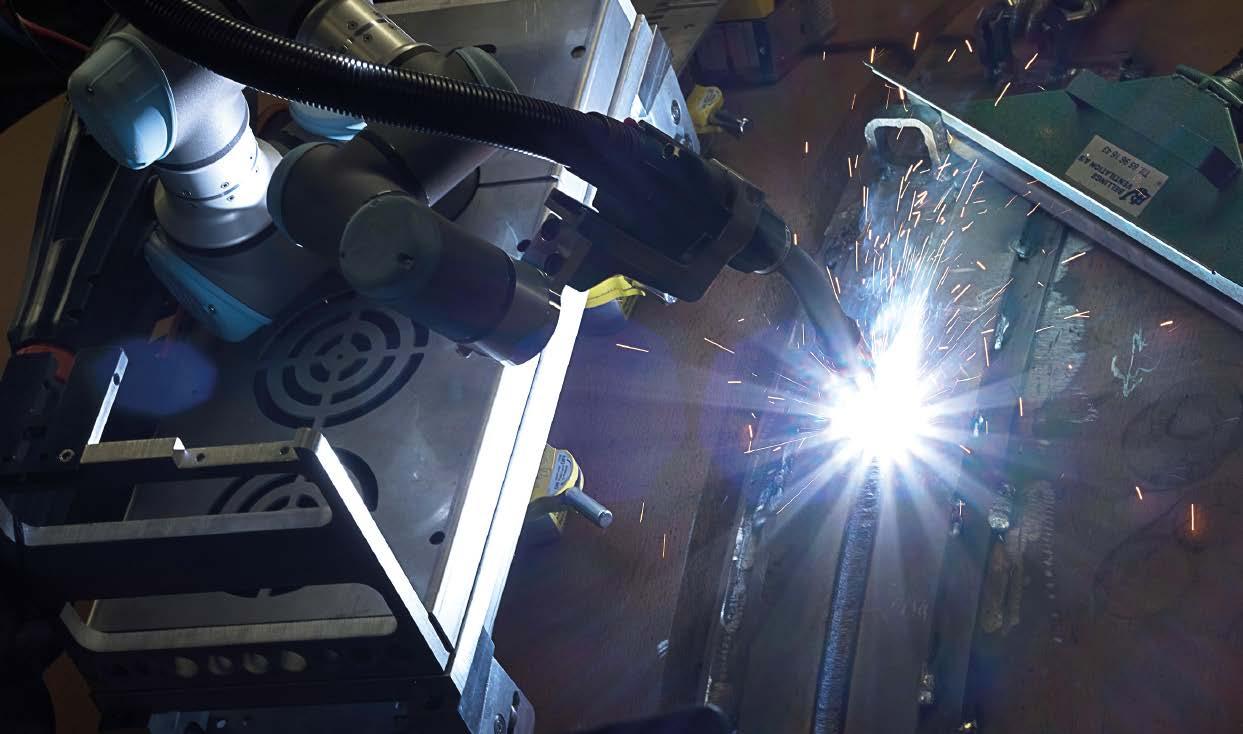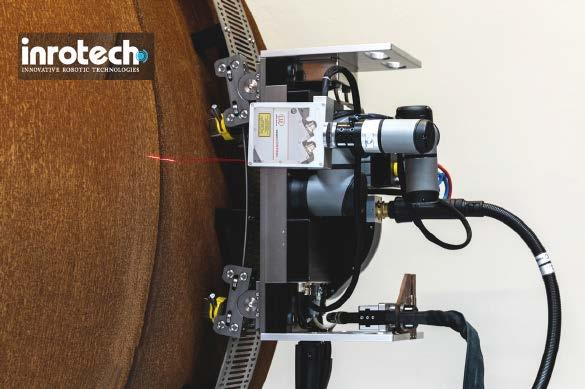
7 minute read
SENSORS
Improved Metal Processing
Laser Scanners Optimize Cutting and Welding Processes
In laser welding and laser cutting, the high degree of automation requires extremely precise tool guidance. The use of laser scanners ensures high product quality in dynamic processes.
Automated processes in the metal industry ensure consistently high product quality and process reliability. Laser scanners from Micro-Epsilon are used in order to meet their high requirements. They intervene even before the cutting and welding work and create precise 2D/3D profiles. Based on this measurement data, exact tool guidance is possible.
Speed, flexibility, and consistently high product quality are required for automated welding and cutting operations in the metal industry. Depending on the manufacturer, the processes can be very individual and complex. Laser scanners from Micro-Epsilon are used to achieve high efficiency. An exact profile of the object to be edited is created before the tool is applied. The tools can then be precisely positioned to carry out the required operational steps.
3D Scan of Components Before Laser Cladding
The laser processing of components is versatile. It ranges from cutting and welding work to coating. Mechanical components are measured three-dimensionally before machining in order to derive the optimum machining processes from the profile data obtained. Laser profile scanners from Micro-Epsilon are used for this purpose.
In laser cladding, a melt pool is created on the surface of the component and a new, pore-free layer is created by adding a powdered filler material. The core task of the sensors is the detection of free forms as well as the recognition of form deviations before laser processing. The components are scanned with a scanControl laser scanner from Micro-Epsilon. If required by the component geometry, this is done from several directions. Regardless of the reflection properties of the material, the sensor constantly provides reliable measurement values. The raw data is transferred directly to the customer software, assembled into a 3D model and finally used for the path planning of the laser welding head. The nozzle can then be placed at the correct distance from the surface and guided along the calculated path. The result is a new, even, and full surface.
Different sensors can be used depending on the intended use, such as repair, 3D printing, joining, or coating and component size. The scanControl 3050-50/BL is ideally suited. This sensor offers a measuring range of 50 mm, with 2,048 measurement points per profile and a measuring rate of up to 10,000 profiles per second. The blue laser line enables precise measurements on metallic surfaces.
Advantages of the Laser Scanner over a Camera Solution
In contrast to a camera solution, laser profile scanners enable the creation of a 3D model and are also surface-independent in terms of contrast. The higher precision, as well as the various integration and processing possibilities of the acquired measurement data, also offer significant advantages in this application. Compared to tactile measurements, the required cycle time is considerably shorter thanks to non-contact measurements.
3D Measurement of Components Prior to Plasma Cutting
The Slovak company MicroStep, spol. is one of the world’s largest producers in the field of automated plasma cutting systems. The company relies on precision sensor technology from Micro-Epsilon in a specially developed machine for processing vessel and boiler covers, the so-called domes, as well as profiled materials. The system can handle domes with diameters up to 7 m and a height of up to 1.2 m. In these domes, openings for pipe and valve connections are normally cut.
In order to process these huge domes quickly, fully automatically and at extreme precision, it is necessary to determine their shape and exact position within the production line. As the pure CAD data of the dome often differs by several centimeters from the actual dimensions, the 3D profile of the covers is measured before processing using scanControl 2900 laser scanners. The exact dimensions are then determined from the 2D data generated by the scanner which is connected to a 6D scanner position system. The scanning process is performed at high speeds up to 60 m/min. Therefore, a reliable hardware trigger is required to obtain the real shape of the target. The precise measurement values are then transferred via an SDK connection as a

Inrotech in Denmark relies on sensors from Micro-Epsilon to achieve optimal quality of weld seams in a fully automatic process. Laser scanners use the triangulation principle for two-dimensional profile acquisition.

point cloud to the customer‘s evaluation software mScan, which calculates the optimum tool path from them. For fully automatic processing of the measured values, synchronizing the scanner data with the data of the processing space is necessary. MicroStep uses a patented auto-calibration (ACTG) system for this purpose.
Advantages of the Laser Scanner
Its compact design with integrated electronics and speed makes the Micro-Epsilon laser scanner suitable for inline integration. In addition, high performance scanners achieve a high repeatability of 50 µm/m even with different reflective properties of the metallic test objects. High repeatability ensures that the process is always carried out at consistently high quality. Furthermore, the measured data can be used to check the quality of the dome. The laser scanner provides a point density of 80 µm over a measuring range of 100 mm.
Optimizing Weld Seams with Profile Measurements
Inrotech in Denmark relies on sensors from Micro-Epsilon to achieve optimal quality of weld seams in a fully automatic process. The company has developed the so-called Inrotech-Crawler which calculates welding processes in advance before carrying them out. Therefore, the robot uses the precise measurement values provided by Micro-Epsilon’s laser profile scanners.
A scanControl scanner is fixed on the Inrotech-Crawler and detects the geometry of the seam to be welded before the actual welding process starts. These high precision profile measurements enable the process to be automated. Based on the optimal exposure time regulation and high resolution, the sensor reliably measures almost any measurement object. Due to its compact, lightweight design with integrated controller, the laser profile scanner is ideally suited to this measurement task. Various connection possibilities offered by the Software Development Kit enable the customer to directly transmit the profile data calibrated to their own software via scanControl DLL. The Weldlogic technology from Inrotech then calculates, among other things, the number of welding processes, the position of the weld seams, the weld speed, and the oscillation width. Directly after the calculation, the Crawler automatically performs the welding process.
Completely Automatic 3D Repair Welding
The laser scanners are also used when welding robots carry out automated repair work. The company Mabotic has developed a method for RWE to automate this repair process. The welding robot enables the scanning of weld geometries such as plates or curves with various surface characteristics. The robot is mobile and is ideal for different environments, e.g., for welding tasks in the oil & gas industry, offshore, shipbuilding, wind turbines and building construction.
For example, it is used for repairs on chain links of lignite excavators. Here it is much more economical to repair the worn parts than to replace the old components with new ones. After around four years of harsh, continuous operation, these steel parts are worn so much that several centimeters of steel are missing in the affected areas. To repair these areas, the missing material would be welded on again by hand over several hours in the conventional way. The welder would have to manually weld on several parallel webs to restore the original shape of the chain link. With the automated process, this procedure takes just minutes.
A resistant sensor is the base requirement in this and many other environments. The laser profile scanner from Micro-Epsilon is ideally suited to these requirements. In the first step, the surface of the defective area is scanned by a laser scanner, which is guided over the surface by a robot. In conjunction with the position data of the robot, the 3D data of the wear point is determined exactly. Thanks to the surface independence of the sensor, pre-treatment of the surface is not necessary. In a second step, the 64,000 measuring points per second are inserted into the CAD target model of the chain link. Therefore, the difference in volume between the high resolution measured values and the target contour is obtained. In the next stage, the optimum welding lines for welding the eroded material in this differential volume are calculated. This entire process is completed in less than three minutes. Finally, the calculated welding lines are transmitted to the robot controller and the automated welding process begins.
Blue Laser Technology
In addition to the red standard laser, Blue Laser Technology is available for measurements on demanding surfaces. Micro-Epsilon holds a patent for measurements with blue lasers on red-hot glowing objects exceeding 700 °C and (semi-)transparent objects. Transparent objects include plastics, glass, adhesives, silicones, paints, coatings, perspex, and seals. For many measurement objects, Blue Laser scanners offer crucial advantages compared to sensors with a red laser diode. Onto organic, glowing materials or semi-transparent objects, the blue laser line is sharply imaged which enables stable and precise results.
Author
Christian Kämmerer, Sales Manager 2D/3D Optical Measurement Technology
pictures ©Micro-Epsilon
Contact
Micro-Epsilon Messtechnik GmbH & Co. KG, Ortenburg, Germany Tel.: +49 8542 168 0 · www.micro-epsilon.de









